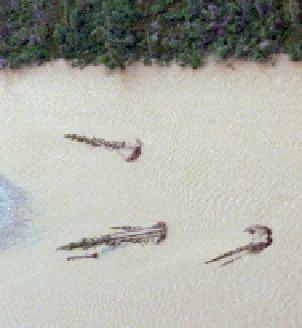Geoscience Reference
In-Depth Information
•
Siliceous fossils:
Fossils with silica tests or frustules
(diatoms and radiolarians for example) survive best in low
pH (acidic) environments because silica is soluble under
high pH (alkaline) conditions. It is therefore unlikely that
diatoms and radiolaria will be found in carbonate-rich
rocks; but note that even in chalk it is common to get
localized variations in chemistry at the time of deposition,
leading to the preservation of silica-rich fossils (e.g. sponge
spicules in fl int).
5
•
Colour:
Colour changes can also be a clue to fi nding fossils.
Look at reduction spots (typically grey or green spots in
otherwise red/brown sedimentary deposits) as these
indicate locally oxygen-poor conditions and may be
associated with organic remains or their derivatives.
•
Change in sedimentation rate:
Changing grain size and/or
an increase in sedimentation rate can also be a clue to
fi nding fossils. Post-mortem oxygen exclusion is related
to the speed of sedimentation. For example leaves
accumulating on the fi ne-grained sedimentary deposits
at the bottom of a lake will often be destroyed by
invertebrates, fungi and bacteria unless buried quickly.
In such cases, look for fossils just below increases in
grain size or other indicators of rapid sediment
deposition.
•
Hydraulic equivalence:
In situations where water is fl owing
(streams, rivers and marine tidal fl ow environments) an
important clue as to where to fi nd fossils is the concept of
hydraulic equivalence. Hydraulic equivalence equates the
hydraulic characteristics (settling velocity, velocity of
entrainment, etc.) of a fossil to that of a quartz grain. So, for
example, a large dinosaur bone or a waterlogged tree trunk
are broadly hydraulically equivalent to a large quartz
pebble or small boulder. It is no surprise then that such
fossils are commonly found in the basal lags of river
channels. Similarly, leaves commonly occur in fi ne-grained
fl uvial siltstones.
5.3.1 Transported or life position?
When you fi nd fossils it is important to determine if they are
preserved
in situ
(autochthonous), transported to the burial site
from where they lived (e.g. Figure 5.5), or even reworked from
an older deposit (allochthonous). Land plant fossils such as
fossilized wood within deep marine sedimentary deposits
clearly indicate transport. This could be over very long
distances because, unless the wood is very abundant, its
presence does not indicate proximity to land as fl oating logs
can circumnavigate the Earth, driven by ocean currents. In
Figure 5.5
Trees stranded in a
shallow river in Alaska showing
similar orientation. River fl ow is
from right to left. Trees are about
10 m long. (Robert A. Spicer, The
Open University, UK.)








